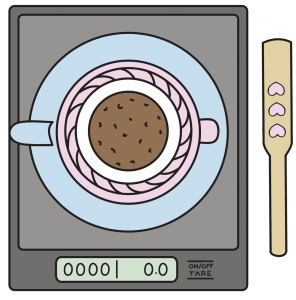Beverage Weight

Illustration of a filter cone and carafe zeroed on a scale
When recipe designers plan out a percolation brew, they consider the total amount of coffee and the total amount of brew water they need. In percolation brewing, the process of starting with dry coffee grinds and finishing up with wet coffee grinds means that there is always some weight loss in the amount of water percolating out the bottom of the coffee bed. Therefore, we need to consider the relationship between the brew water we start with and the beverage weight we finish with.
Coffee grinds are made up of an organised arrangement of cells, each approximately 50 um) in diameter. The roasting process causes the cellulose that holds these cells together to expand and rip open. The end result is a series of caverns and hollow regions that act just like a sponge. There is a limit to how much water a sponge can actually hold, so the grinds don’t steal too much of our brew water from us; the maximum retention typically measures in at between 2 and 2.5 grams of brew water per gram of coffee grinds. We call this relationship between the coffee dosed, and the liquid the spent grinds hold on to, the liquid retained ratio.
If you remove the filter cone immediately after the drawdown has finished, you will retain slightly more water in the grinds. If you leave your brew to draw down for several minutes, you will allow additional drips to add to the beverage weight. To ensure consistency in your beverage weights between separate batches, it is necessary to standardise the amount of time you allow a brew to draw down.
The Margin of Error for Brew-water
As mentioned earlier, the margin of error for a pour-over is established by the recipe designer. It is usually larger than the margin of error for dosing because pour-overs are usually made with around 16 times more water than coffee grinds.